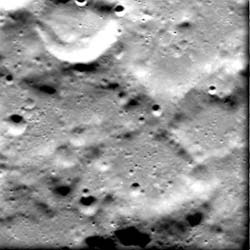Landscapes from the ancient and eroded lunar far side

Credits: ESA/SMART-1/Space-X (Space Exploration Institute)
AMIE obtained this image on 1 January 2006, from a distance of 1483 kilometres from the surface, with a ground resolution of 134 metres per pixel. The imaged area is centred at a latitude of 4.2º South and longitude 98.4º East.
The Moon's rotation is locked to the Earth, that is the Moon always presents roughly the same side to the Earth. We call the side facing the Earth the ‘near side’, while the side facing away is the ‘far side’.
After the first lunar missions orbited the Moon, it was discovered that unlike the near side, the far side is lacking large lava plains, the so-called ‘maria’. The far side is mainly composed of heavily cratered highlands, while only very small areas contain smooth lava plains.
The reason for this difference between near side and far side is not exactly understood. Could the tidal pull of the Earth on the Moon – just like the Moon introduces tides on the water bodies of the Earth – have resulted in such a difference?
The modelling of previous topography and gravity measurements indicate that the solid crust is thinner on the near side. As a consequence, large impacts could excavate the crust more easily on the near side, and so lava had an easier way to flow out and create maria formations.
This image shows some highly eroded highland area on the lunar far side. Many craters are almost not longer visible, as they were destroyed by subsequent impacts.
Media Contact
More Information:
http://www.esa.int/SPECIALS/SMART-1/SEMDWNWALPE_0.htmlAll latest news from the category: Physics and Astronomy
This area deals with the fundamental laws and building blocks of nature and how they interact, the properties and the behavior of matter, and research into space and time and their structures.
innovations-report provides in-depth reports and articles on subjects such as astrophysics, laser technologies, nuclear, quantum, particle and solid-state physics, nanotechnologies, planetary research and findings (Mars, Venus) and developments related to the Hubble Telescope.
Newest articles

Recovering phosphorus from sewage sludge ash
Chemical and heat treatment of sewage sludge can recover phosphorus in a process that could help address the problem of diminishing supplies of phosphorus ores. Valuable supplies of phosphorus could…

Efficient, sustainable and cost-effective hybrid energy storage system for modern power grids
EU project HyFlow: Over three years of research, the consortium of the EU project HyFlow has successfully developed a highly efficient, sustainable, and cost-effective hybrid energy storage system (HESS) that…

After 25 years, researchers uncover genetic cause of rare neurological disease
Some families call it a trial of faith. Others just call it a curse. The progressive neurological disease known as spinocerebellar ataxia 4 (SCA4) is a rare condition, but its…





















